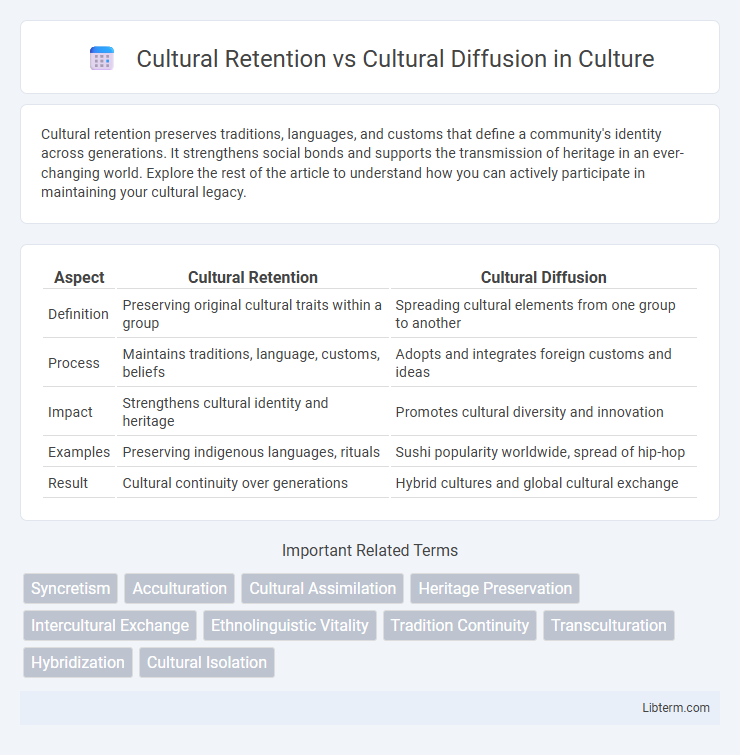Cultural retention preserves traditions, languages, and customs that define a community's identity across generations. It strengthens social bonds and supports the transmission of heritage in an ever-changing world. Explore the rest of the article to understand how you can actively participate in maintaining your cultural legacy.
Table of Comparison
| Aspect | Cultural Retention | Cultural Diffusion |
|---|---|---|
| Definition | Preserving original cultural traits within a group | Spreading cultural elements from one group to another |
| Process | Maintains traditions, language, customs, beliefs | Adopts and integrates foreign customs and ideas |
| Impact | Strengthens cultural identity and heritage | Promotes cultural diversity and innovation |
| Examples | Preserving indigenous languages, rituals | Sushi popularity worldwide, spread of hip-hop |
| Result | Cultural continuity over generations | Hybrid cultures and global cultural exchange |
Understanding Cultural Retention and Cultural Diffusion
Cultural retention refers to the preservation of cultural practices, beliefs, and values within a community over time, maintaining distinct identities despite external influences. Cultural diffusion involves the spread of cultural elements such as language, religion, technology, and customs from one society to another, facilitating cultural exchange and adaptation. Understanding the dynamics between cultural retention and diffusion is essential for analyzing how cultures evolve, retain heritage, and respond to globalization.
Historical Contexts: Roots of Retention and Diffusion
Cultural retention stems from historical contexts where societies maintain traditions, languages, and customs to preserve identity amid external influences and colonization. In contrast, cultural diffusion occurs through migration, trade, conquest, and communication, enabling the exchange and blending of practices across regions and civilizations. Prominent examples include the retention of Indigenous beliefs despite colonial pressures and the diffusion of technologies and religious ideas along the Silk Road.
Key Drivers of Cultural Retention
Key drivers of cultural retention include strong family structures, religious practices, and community institutions that reinforce traditional values and customs. Linguistic preservation plays a critical role, as language serves as a primary vessel for transmitting cultural identity across generations. Social norms and educational systems that emphasize heritage knowledge further solidify a community's commitment to maintaining distinct cultural traits amid external influences.
Factors Influencing Cultural Diffusion
Factors influencing cultural diffusion include geographical proximity, trade routes, and communication technologies, all of which facilitate the exchange of ideas and customs between societies. Social networks and migration patterns significantly impact how quickly and widely cultural traits spread across regions. Political stability and openness, along with language compatibility, also play crucial roles in enabling or restricting the flow of cultural elements between different populations.
Globalization: Threat or Opportunity for Traditions?
Globalization accelerates cultural diffusion by spreading ideas, customs, and innovations across borders, often leading to the blending or loss of traditional practices. However, it also creates opportunities for cultural retention through increased access to global platforms that promote and preserve indigenous identities. Balancing globalization's influence requires strategic efforts to protect cultural heritage while embracing beneficial exchanges that enrich global diversity.
Cultural Identity: Navigating Continuity and Change
Cultural identity thrives on the balance between cultural retention and cultural diffusion, where retention maintains traditional practices, languages, and values that strengthen a community's sense of belonging. Cultural diffusion introduces new beliefs, customs, and innovations through interaction with other societies, fostering adaptability and evolution within cultural identities. Navigating this dynamic ensures continuity while allowing cultural identities to transform, reflecting both heritage preservation and contemporary influences.
Case Studies: Success Stories and Challenges
The case study of the Maori in New Zealand highlights cultural retention through language revitalization programs that have successfully preserved indigenous identity while facing challenges from globalization pressures. In contrast, the spread of Korean pop culture worldwide demonstrates cultural diffusion as it merges traditional elements with global trends, resulting in economic growth but also concerns over cultural commodification. Both cases reveal that balancing heritage preservation with adaptive cultural exchange is critical for sustainable cultural development.
Impacts on Language, Art, and Heritage
Cultural retention preserves indigenous languages, traditional art forms, and heritage, reinforcing community identity and historical continuity. In contrast, cultural diffusion introduces new linguistic elements, artistic styles, and heritage influences, fostering innovation but sometimes diluting original cultural expressions. The interplay between retention and diffusion shapes evolving cultural landscapes, balancing preservation with adaptation.
The Role of Technology in Spreading and Preserving Culture
Technology plays a crucial role in cultural diffusion by enabling rapid sharing of customs, languages, and traditions across global digital platforms, such as social media and streaming services. Simultaneously, technological tools like digital archives, virtual reality museums, and language preservation apps support cultural retention by safeguarding indigenous knowledge and heritage from extinction. Advances in communication technology empower communities to maintain cultural identity while participating in the global exchange of cultural practices.
Balancing Cultural Preservation and Openness in a Connected World
Balancing cultural retention and diffusion involves maintaining heritage practices while embracing influences from global interactions, ensuring communities preserve identity amidst change. Effective cultural preservation supports language, rituals, and traditional arts, fostering continuity and belonging. Openness to cultural diffusion enables adaptation, innovation, and cross-cultural understanding, which enrich societies and promote peaceful coexistence in an interconnected world.
Cultural Retention Infographic

 libterm.com
libterm.com